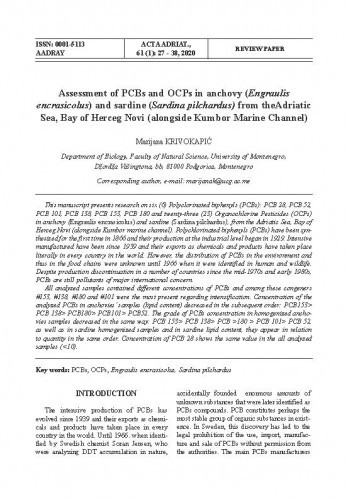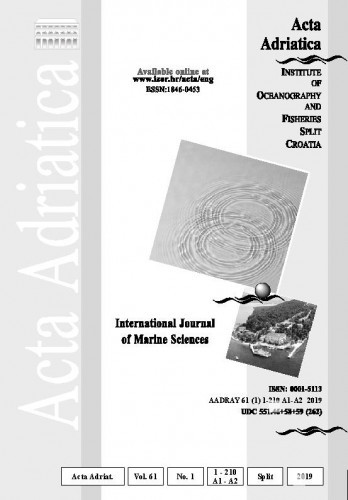This manuscript presents research on six (6) Polyclorinated biphenyls (PCBs): PCB 28, PCB 52, PCB 101, PCB 138, PCB 153, PCB 180 and twenty-three (23) Organochlorine Pesticides (OCPs) in anchovy (Engraulis encrasicolus) and sardine (Sardina pilchardus), from the Adriatic Sea, Bay of Herceg Novi (alongside Kumbor marine channel). Polychlorinated biphenyls (PCBs) have been syn-thesized for the first time in 1866 and their production at the industrial level began in 1929. Intensive manufactured have been since 1939 and their exports as chemicals and products have taken place literally in every country in the world. However, the distribution of PCBs in the environment and thus in the food chains were unknown until 1966 when it were identified in human and wildlife. Despite production discontinuation in a number of countries since the mid-1970s and early 1980s, PCBs are still pollutants of major international concern. All analyzed samples contained different concentrations of PCBs and among these congeners #153, #138, #180 and #101 were the most present regarding intensification. Concentration of the analyzed PCBs in anchovies’ samples (lipid content) decreased in the subsequent order: PCB153>PCB 138>PCB180>PCB101>PCB52. The grade of PCBs concentration in homogenized ancho-vies samples decreased in the same way: PCB 153>PCB 138>PCB >180 >PCB 101>PCB 52, as well as in sardine homogenized samples and in sardine lipid content, they appear in relation to quantity in the same order. Concentration of PCB 28 shows the same value in the all analyzed samples (<10).; U ovom radu je predstavljeno istraživanje šest (6) polikloriranih bifenila (PCBs): PCB 28, PCB 52, PCB 101, PCB 138, PCB 153, PCB 180 i dvadeset i tri (23) organohlornih pesticida (OCPs) u brgljunu (Engraulis encrasicolus) i srdeli (Sardina pilchardus) iz Jadranskog mora, zaljev Herceg Novi (uz morski kanal Kumbor). Poliklorirani bifenili (PCB) prvi su put sintetizirani 1866., a njihova proizvodnja na industrijskoj razini započela je 1929. Intenzivno se proizvode od 1939., a njihov izvoz kao kemikalija i proizvoda odvijao se doslovno u svim zemljama svijeta. Međutim, raspodjela PCB-a u okolišu i prema tome u prehrambenim lancima bila je nepoznata sve do 1966., kada su otkriveni u ljudima i u okolišu. Unatoč obustavi proizvodnje u mnogim zemljama od sredine 1970-ih i početka 1980-ih, PCB su i dalje zagađivači od velikog međunarodnog značaja. Svi analizirani uzorci sadržavali su različite koncentracije PCB-a. Među analiziranim kon-generima: #153, #138, #180 i #101 bili su najzastupljeniji. Koncentracija analiziranih PCB-a u uzorcima brgljuna (lipidi) smanjuje se sljedećim redoslijedom: PCB153>PCB 138>PCB180>PCB101>PCB52. Stupanj koncentracije PCB-a u homogeniziranom uzorku brgljuna opada na isti način: PCB153>PCB 138>PCB>180.>PCB101>PCB52, kao i u uzorcima srdele, koncentracija kongenera pojavljuje se istim redoslijedom. PCB 28 pokazuje istu vrijednost u svim analiziranim uzorcima (<10).
Sažetak

 Acta Adriatica : 61,1(2020) / glavni urednik Jakov Dulčić.
Acta Adriatica : 61,1(2020) / glavni urednik Jakov Dulčić.